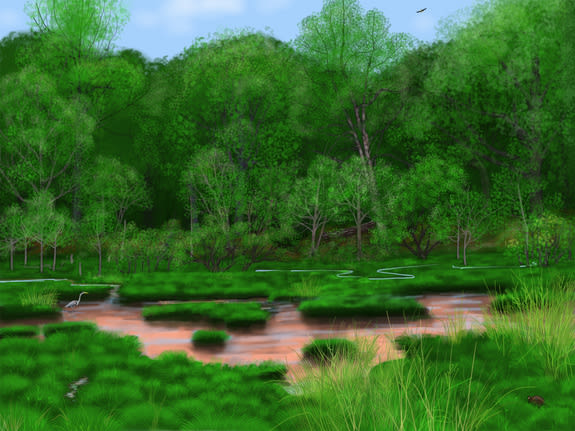
Now, thanks to a rare fossil discovery in the Pennsylvania foothills, scientists can tell the full story of America's lost forests.
The fossil site is a muddy layer packed with leaves from hardwood trees
that lived more than 300 years ago along Conestoga Creek in Lancaster
County, Pa. The muck was laid down before one of Pennsylvania's 10,000
mill dams, called Denlinger's Mill, was built nearby, damming the stream
and burying the mud and leaves in sediment.
Researchers from Penn State University discovered the fossil leaves
while investigating the lingering effects of milldams. The thousands of
small dams — which powered mills, forges and other industry — changed
the water table, altering the plants growing nearby and eventually
changing the landscape from wetlands to deeply incised, quickly flowing
streams.
Before Europeans arrived, American beech, red oak and sweet birch trees
shaded Conestoga Creek, according to a study the researchers published
today (Nov. 13) in the journal PLOS ONE. Some 300 years later, those trees are gone. The same spot is now home to mostly box elder and sugar maple trees, said Sara Elliott, the study's lead author and a research associate at the University of Texas at Austin's Bureau of Economic Geology.
"This is a very unusual opportunity to compare modern and fossil forest assemblages," Elliott told LiveScience. "It's like you're time traveling," she said.
Elliott carefully peeled apart hundreds of leaves stuck together by mud
and layered like a pile of sticky notes. Washing the leaves in a
variety of chemical baths helped Elliott determine the leaves' structure
and species.
Other kinds of trees found in the fossil layer that have since vanished from North America
include the American chestnut, which was attacked by an imported fungal
disease called the chestnut blight. Leaves from swamp plants also
appear in the mud, confirming that the forested spot was on the upslope
edge of a nearby wetland.
"We had a valley margin forest growing right next to the valley bottom
in conjunction with all these wetlands," Elliott said. "I think we
really have a rather complete picture now of what the landscape was like
in this region."The three dominant tree species found in the fossil forest leaves still exist today in the Northeast, but in different proportions and in different places, Elliot said.
The scientists hope that identifying similar fossil tree-leaf sites will help the massive milldam restoration projects underway throughout the Northeast. The dams left a legacy of toxic sediment piled up behind their walls, as well as reshaped the landscape.
"Having a more complete and enhanced understanding of this past dynamic and complex landscape will help in restoring an ecologically diverse and functional system," Elliott said.

No comments:
Post a Comment